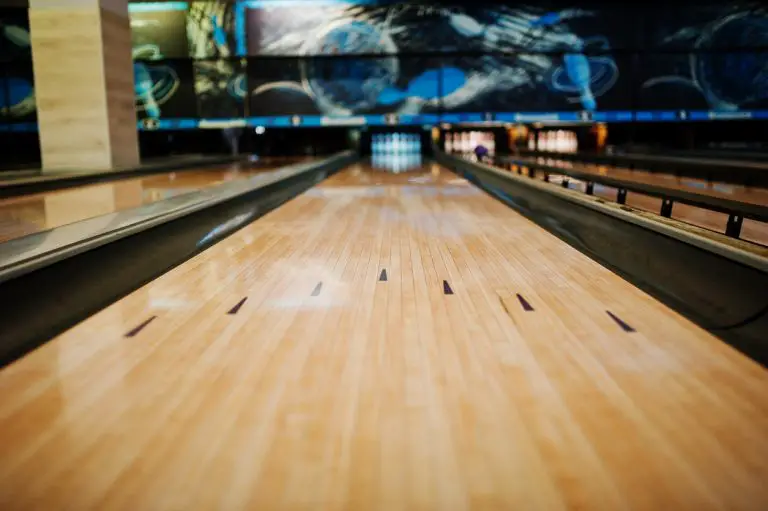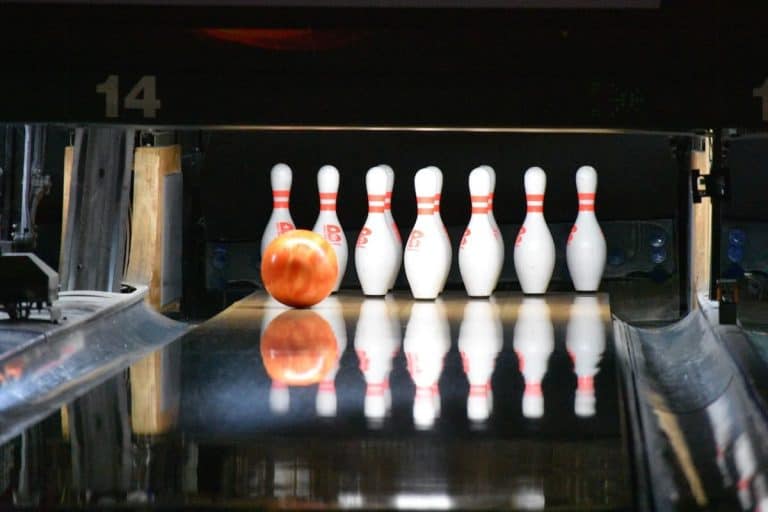5 Reasons Your Bowling Ball Cracked
Bowling is a sport that don’t require much in terms of equipment, making the sport relatively cheaper than others. Your ball and shoes are all that’s needed. But if you have to repair or replace damaged bowling balls on a frequent basis, this can raise cost and frustration.
Bowling balls crack due to various factors. Reasons include extreme temperatures (hot and cold), air exposure for newer balls, moisture, and incorrect storage. Incorrect techniques, such as bouncing your rolls or throwing hard can decrease life span of a bowling ball.
If your bowling ball keeps cracking, and for the life of you, you don’t understand why it keeps happening, then this article is for you. We will quickly cover what a bowling ball is made from, and then we will go over the reasons why your ball keeps cracking and how to prevent this in the future.
Bowling ball overview
Before we try to understand why bowling balls crack, we first need to know how they are designed and what materials are used for manufacturing. This is because if we know these aspects of a bowling ball, we will understand better why they often do crack. This holds true even for pricier bowling balls.
A bowling ball’s coverstock (the outside shell of the ball) can be made from various materials, including plastic, urethane, reactive resin, and particle (proactive). It is vital to take note that these materials are affected by extreme weather conditions (hot and cold) and are also susceptible to moisture. This means that they can expand and contract (swell and shrink) due to these factors and how severe they are.
The next thing to note about a bowling balls design is that the core is made up of metal oxides such as calcium or iron oxide that are mixed with resin and a catalyst. What is essential to understand about a bowling ball’s core is that due to its weight and the significant amount of pressure the core can place on one square inch of the coverstock, it is sometimes susceptible to cracking.
Not to mention that the core is subject to expanding and contracting, as is the coverstock and any filler material that the ball may be made with.
Remember that these materials that a bowling ball is made from has the potential to cause cracks but are not always the culprit, as you will see.
What would cause a bowling ball to crack?
You may not know it, but there are several factors to consider as to why your bowling ball could crack.
The major cause of why bowling balls crack can mainly be associated with extreme temperatures and incorrect storage. Due to the way bowling balls are designed and manufactured (as we discussed), the weight of the core and how it expands and contracts along with the coverstock due to severe weather conditions will cause it to crack.
These extreme weather and storage conditions can also cause the bowling ball to sweat (in heat) or fade (discolor), increasing your bowling ball’s cracking susceptibility.
Moisture and air exposure are the last conditions that can cause your bowling ball to crack, and although many individuals may not know it, this is a major cause of cracked bowling balls.
5 Reasons Your Bowling Ball Cracked
We have laid out and detailed all the reasons why your bowling ball will crack, and some of these reasons are not so well known, while others can be sub-categorized, as you will see.
It is crucial that you consider all of these reasons why your bowling ball would crack and prevent them as much as possible, which we will discuss in the following section.
Moisture can cause your bowling ball to crack
Moisture is one of the most common problems that you will face when trying to store your bowling ball, causing it to crack.
Not only is it susceptible to moisture (it will soak it up) due to the materials that the coverstock is made from, if it is placed on a porous surface such as wood or even the floor, it will tend to displace the moisture in it into those surfaces.
You can think of a bowling ball like a wet sponge. When placed on a surface like wood, the wood will soak up the water from the sponge, making it dry. The same effect applies to a bowling ball; however, the coverstock, instead of becoming dry, becomes dry and brittle, causing it to crack.
Air exposure can cause your bowling ball to crack
One aspect to note that relates to moisture is air exposure. One way to accelerate the evaporation of the coverstock is to use dry heat to remove oils from the bowling balls’ surface. This is not recommended and is, in fact, condoned by Ebonite, a professional bowling ball manufacturer.
Bowling balls are cured at precise temperatures over a particular amount of time and are typically fully cured by the time they leave the factory. However, many balls continue to cure over a period of months and even years.
Therefore, if you do not store your bowling ball correctly if it is new, it may be susceptible to cracking due to the curing process still taking place.
Extreme temperatures can cause your bowling ball to crack
Extreme temperatures are the next common cause of why your bowling ball has cracked. Many individuals live in regions where they can experience severe weather conditions throughout the year, including freezing cold conditions and sweltering conditions.
Due to the nature of how a bowling ball is designed and what materials it is made of, these elements will contract or expand, causing them to crack or break.
Phasing can cause your bowling ball to crack
Pashing is an effect by which the color of your bowling ball will change and cause discoloration. This is commonly due to freezing temperatures.
If you find that your bowling ball has some form of discoloration, then this could be the problem. Remember that cold conditions will cause the coverstock and core to contract (shrink), and then once it is stored out of the cold, it will revert back to room temperature.
This process causes it to inflate at a relatively fast speed, and thus the coverstock being made of reasonably rigid materials can’t expand fast enough. This causes it to crack. Take note that in some extremely cold weather conditions, even the core has been known to contract.
Sweating can cause your bowling ball to crack
Conversely, you may be staying in a region that experiences scorching temperatures. You might notice that it has some oil covering the coverstock if you pull your ball out of your bag.
This is a chemical reaction that takes place when the bowling ball encounters too much heat. Oils are literally pulled and pushed out from the coverstock and core due to the expanding nature of the materials.
Incorrect storage can cause your bowling ball to crack
You may not know it, but storage is a major problem causing bowling balls to crack. This is due to the fact that most bowlers leave their ball in a bag in the car or in the garage, and it sits there (sometimes for months on end).
Incorrect storage can be combined with severe weather and placing it on porous materials such as wood, but we are mainly concerned with the fact that the ball is stored in one position for an extended period of time.
The core of a bowling ball is very dense and heavy, and when placed to sit on a flat surface like a shelf or floor, the core pushes hard against one square inch of the coverstock.
Over a long period of time, the tremendous amount of weight placed on the one square inch of coverstock tends to wear down and, thus, subsequently cracks due to this pressure.
How to prevent a bowling ball from cracking
You may be considering that too many elements can play a role in causing your bowling ball to crack, and you may be thinking it’s a lost cause to try and prevent it. However, there are simple rules to follow that can help you save money on your newly acquired bowling ball.
How to prevent a bowling ball from cracking in extreme temperatures
Regarding extreme temperatures, you will have to make sure that you try and keep your bowling ball at room temperature most of the time.
This means that you should wrap it up in something like a towel and place it into a bag. When storing it and moving it, make sure that the associated room or vehicle you are traveling in is set to room temperature.
You can do this via the air conditioning unit in your car or by purchasing a heater, fan, or air conditioning unit for that specific room. If you are not up for purchasing a heater and leaving it on all winter in your garage, then your best bet is to keep your bowling ball stored somewhere else, like in your clothing cupboard.
How to prevent a bowling ball from cracking due to moisture and air exposure
If you have a new bowling ball, your best bet is to place it inside some form of a zip-lock bag. This will help prevent excess air exposure and moisture loss along with moisture uptake.
Keep in mind that you should not place your bowling ball on any porous surfaces, as we discussed, such as wood, paper, cardboard, and fabric.
We said that you should consider a towel to store your bowling ball, but another great option that will prevent any moisture from getting in or out is bubble wrap.
How to prevent a bowling ball from cracking due to incorrect storage
We discussed not placing your bowling ball on any porous surfaces as well as trying to keep them shielded from extreme temperatures (hot and cold). These two factors have to be considered when storing your bowling ball, along with how long you intend to store your bowling ball.
Many bowlers sometimes store their bowling balls from June until September because this is when their fall league will begin. Hence, the bowling ball is stored in the same location for months. It is all good and well that the location of your stored ball is fine in temperature and is not lying on a porous surface. However, the sheer weight and pressure of the core will play havoc with the elastic coverstock.
We said that the core puts a ton of pressure on one square inch of the coverstock, and as such, if this occurs over a long period of time, the part of the coverstock that the ball is constantly resting on will crack.
All you need to do to prevent this from happening is to turn your bowling ball every so often. Every couple of days should suffice. This means that the pressure on the part of the coverstock that is taking all the weight from the core is being relieved.
Conclusion
We discovered that a bowling ball is quite a delicate object that is made from various materials. Combined, these materials that make up a bowling ball are susceptible to cracking from extreme temperatures (both cold and hot), and one warning sign of this is phasing and sweating.
Phasing occurs when the bowling ball becomes discolored due to extreme cold. The coverstock and, in some cases, the core and contract too much, causing it to crack.
Sweating is when the bowling ball encounters too much heat, and the subsequent expansion of the core pushed oil out onto the surface of the ball.
Moisture, air exposure, and incorrect storage of your bowling ball are other reasons that can cause your bowling ball to crack, as we found out.
Although there is no remedy for a cracked ball other than to try to get it repaired or to purchase a new one, there are many things that you can do to prevent this.
We concluded that always trying to keep your ball at room temperature is one of them, while wrapping them in a towel or bubble wrap can help with air exposure and moisture. Finally, giving your bowling ball a turn or two when it’s in storage will help prevent the core from pacing too much weight in one area.
Source list
Why Bowling Balls Crack. How to Protect Your Bowling Equipment.
What Causes a Bowling Ball to Crack and How To Help Prevent It From Happening





